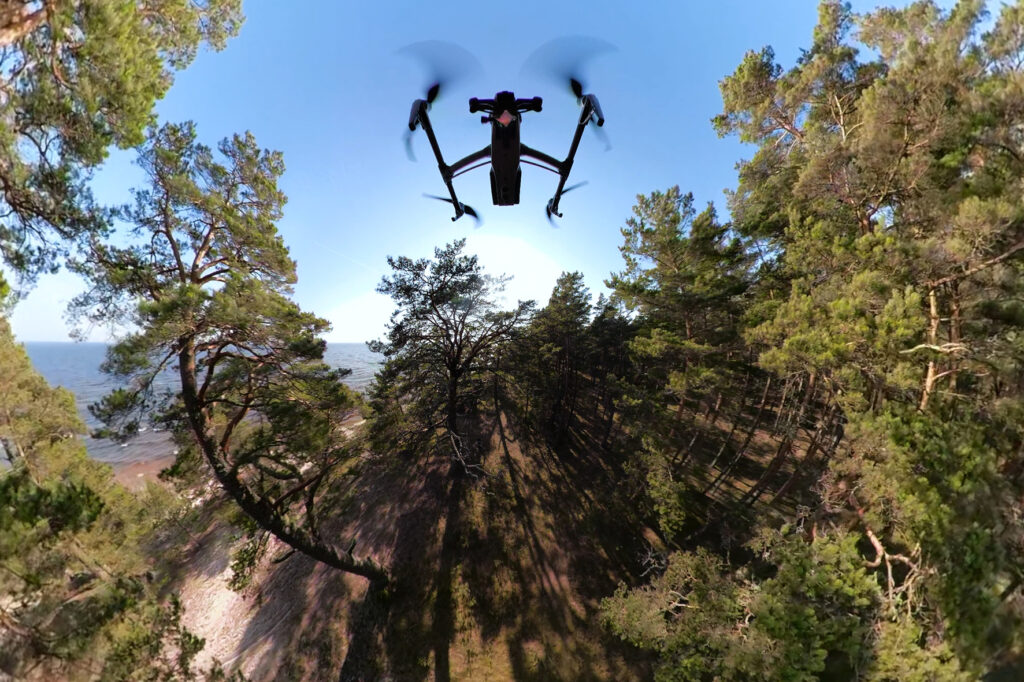KOKKUVÕTE
Mehitamata õhusõidukite areng ulatub 19. sajandi keskpaika, kus nende teekond sai eranditult alguse sõjatööstusest. Töö käigus selgus, et puldiga juhitavate lennumasinate arengule aitasid oluliselt kaasa erinevad mudellennukite ehitajad ja hobiharrastajad.Tänu neile on droonindus saanud võimalikuks ka filmitööstuses, kus liideti kaamera ja lennumasin. Tollel ajal ei eksisteerinud drooni sellisel kujul, nagu oleme tänapäeval harjunud. Selle asemel kasutati puldiga juhitavaid lennukeid ja helikoptereid, mida hakati kasutama koos erinevate kaameratega. Selgus, et alguses polnud selliste masinatega filmitud video täiestisujuv, kadreerimine oli keeruline, seadistamine nõudis aega ja lennuaeg oli lühike. Sellest hoolimata jõudis droonindus ka Eestisse,kus esimesena hakkas produktsiooniettevõtetele teenust pakkuma Helicam. Nemad olid ka esimesed, kes pakkusid täisteenust droonimaastikul Eestis. Üks asutajatest, Ville Hyvnönen, tegeles samuti varasemalt hobikorras puldiga juhitavate helikopteritega. Tema koostöösKristjan Tiimusega sündis ettevõte, mis pakkus teenust üle maailma, kelle filmitud droonikaadrid on jõudnud paljude teleekraanile. Droonid on võimaldanud näidata uut perspektiivi ja lisanud filmimeeste arsenali uue tööriista, mille kasutamine on muutunudväga populaarseks, kui mitte hädavajalikuks. Tänu droonidele on erinevad filmid ja reklaamid muutunud visuaalselt mitmekülgsemaks ja paeluvamaks. Kogu filmimise protsess on muutunud odavamaks, laiahaardelisemaks ja ohutumaks.Selgus, et mehitamata õhusõidukite seadustes Eestis leiab mitmeid puudujääke. Droonide areng on nii kiire, et seadused ei jõua sellele järgi. Selle tõttu on droonipilootidel vabadust rohkem seadusi eirata või käitada seda lennumasinat keelatud kohtades. Lisaks kerkis esile eetilisuseküsimus drooniga lendamisel, sest teatud kohtades pole seda mõistlik teha. Mõistlikult talitades ja läbirääkides on siiski võimalik drooni lennutada peaaegu igal pool. Kõige olulisem on kasutaja enda vastutustunne ja talitlemine olukordades, kus võib tekkida probleeme. Kui seadustega pole kõik piisavalt selgelt reguleeritud, siis tuleb ise kaasa mõelda ja tunnetada eetilisuse piire.Droonide tarkvara on ajaga muutunud üsnagi usaldusväärseks ja süsteemi vigasid esineb harva. Paraku suur osa nende lennumasinate õnnetustest on kasutaja enda tähelepanematus ja eksimus. Järelikult kohusetundlikult ja teadlikult droonide käitamine on eelduseks erinevate õnnetuste ja ohutust puudutavate aspektide vältimiseks.Tänu sellele lõputööle sain kõik oma mõtted kompaktselt kirja panna. Ma siiralt loodan, et lugejad saavad sellest midagi õppida ja kasutada minu näpunäiteid ja soovitusi oma drooninduse teekonnal. Antud töö aitas mindlapsepõlveunistusel sooviga lennata linnuna taevas. Tänu virtuaalreaalsusele pole ma enam lindude peale kade.
SUMMARY
I had an interest in flying as a child. I was jealous of the birds, who could see the world from a completely different perspective. I built and tested various model airplanes, which at first failed to take off. I bought myself various remote-controlled helicopters and planes until I discovered the drone for myself. Since then, I have been actively involved and learning to operate drones, which led me to the film production industry.The first experiments with remote-controlled helicopters were made in Estonia in 2005, when Canon 5D series cameras went on sale. At that time, it was all so expensive that Estonian production companies could very rarely afford something like that, but the first experiments were made in the form of music videos.The first ones who were offering the service in Estonia in 2007 was Helicam OÜ. Ville Hyvönen came to Estonia from Finland and met Kristjan Tiimus, who had previously built large remote-controlled helicopters. Ville was already involved in filmmaking and enjoyed working with remote-controlled helicopters as a hobby. He was greatly inspired by the Belgian company Flying-Cam, which already used remote-controlled helicopters to make films. They used it in various films such as: Legend of Bagger Vance (2000), various Harry Potter films and The Kire Runner (2007). These were the first major films to use an unmanned aircraft for filming. As a result of the cooperation between Ville and Kristjan, they made a company that operated until 2018. Their main goal was to provide a drone service for making feature films. In 2011, drones began to be used instead of helicopters. Their biggest projects are for 20th Century Fox TV series. For example, they made drone shots for series like Homeland and Prison Break, both of which are also available on Netflix. Drones have provided a variety of opportunities in the film and advertising industries. They are considered by the film industry to be a cheaper and safer option than a helicopter. Due to their compactness and flight characteristics, it is possible to film shots that were not possible before. They add a whole new perspective to the video landscape. Because drones can be used at very different heights, this has made filming much easier. As a result, cranes, special film cars, and all kinds of sliders can be partially replaced during shooting. These aircrafts have given us the opportunity to cut costs and operate them more safely because they are smaller in size than an airplane or helicopter. As a result, they can also be flown indoors. When flying, the noise level of drones is significantly quieter than on larger aircraft. Drones will give us a better overview when looking for different shooting locations.
Although drones can be flown even in more severe weather conditions, special care must be taken. Their technology is sensitive to water droplets and moisture, but by operating wisely, you can also fly in more extreme conditions.The most interesting views open from a height of 5-40 meters, which is not accessible by helicopter. Using technical knowledge and skills, it is possible to achieve very cinematic shots with these aircrafts. The Civil Aviation Administration has established rules that apply to all users of unmanned aircraft, be it a drone or another flying object without a pilot on board. Airspace is divided into two: controlled and uncontrolled airspace. Most of Estonia’s surface is uncontrolled airspace, but mainly larger cities such as Tartu and Tallinn have controlled airspace. In addition, there are a number of temporary restricted areas of which the pilot must be aware. The drone industry is growing at 13-18% a year, and the US and Europe have not yet been able to catch up with this growth by law. Due to this, there are also several shortcomings in Estonian drone laws, mainly in connection with the permit to fly. Although the law sets certain rules, the question of ethics also arises. In some places it is not polite to fly, even if the law allows. These include, for example, private houses, zoos, monasteries, private estates and much more. Safety must also be taken into account when flying drones. As with any technical gadget, there is always a chance that a defective product will leave the factory and cause the drone to fall. However, the drone’s own software is relatively foolproof, and usually these things don’t happen. Unfortunately, most accidents happen due to user error or ignorance. Power lines, empty batteries, faulty propellers, incorrectly set technical parameters, flying too far or overestimating one’s own flying skills are often overlooked.In the practical part of the dissertation, I attached a 360°camera to the drone body, as a result of which I was able to film a spherical video. Thanks to this, you can film the whole world around us in one frame. By using virtual reality glasses, which are gaining popularity today, it is possible to experience this video through the eyes of a bird, where the viewer can look around during the duration of the video. I focus on the visual experience rather than the maneuverability of the bird. Thanks to virtual reality, I am no longer jealous of birds that can see everything from above.
Teose andmed
Failid







